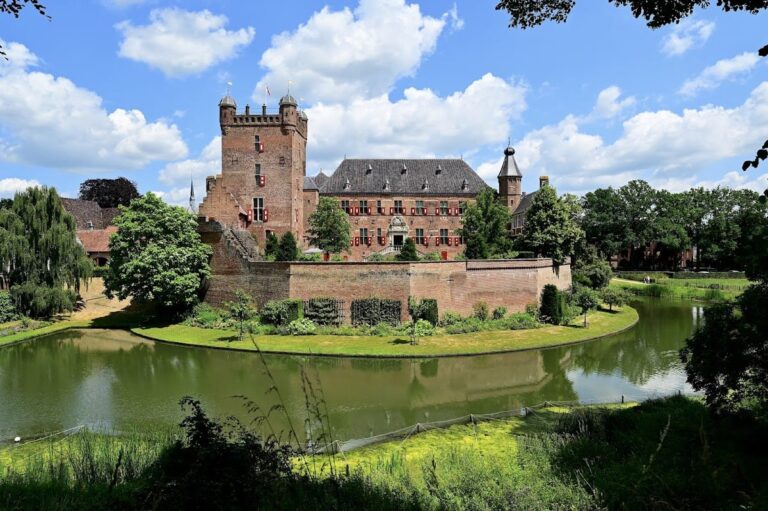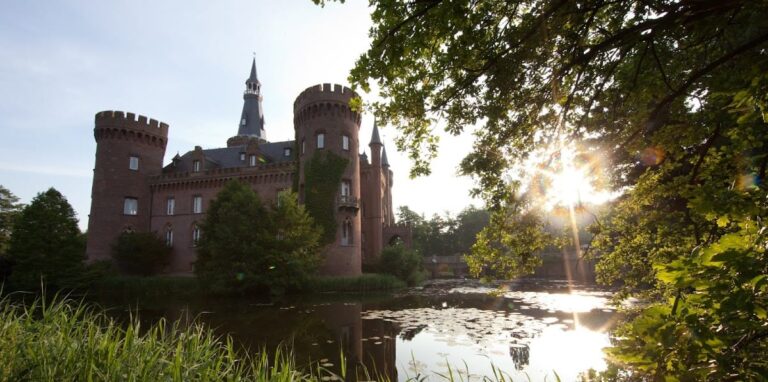Doorwerth Castle: A Historic Water Castle in the Netherlands
Visitor Information
Google Rating: 4.5
Popularity: Medium
Google Maps: View on Google Maps
Official Website: www.glk.nl
Country: Netherlands
Civilization: Medieval European
Remains: Military
History
Doorwerth Castle is located near the village of Doorwerth in Gelderland, the Netherlands. It originated as a medieval water castle, first recorded in 1260 when it was attacked, captured, and burned by the lord of Vianen. This assault was likely ordered by the Count of Gelderland to stop raids by Lord Berend van Dorenweerd, the castle’s early owner or his family.
Within two decades after its destruction, the castle was rebuilt. Sources suggest that either Berend van Dorenweerd or his son Hendric initiated the reconstruction, with some accounts dating the foundation of the new water castle, complete with a moat, to around 1280 under Hendric’s direction. This marked the transition from a wooden fortification to a stone structure.
In 1435, Reinald van Homoet acquired Doorwerth Castle and undertook major expansions and modernization. He enlarged the southern wing and moved the main entrance, reflecting changing defensive and residential needs. Further building continued through the 15th and 16th centuries. Around 1560, Adam Schellaert van Obbendorf unified the castle and its outer bailey into a single complex, enhancing its defensive and functional coherence.
The castle survived the turbulent Dutch “Rampjaar” of 1672, a year of military crisis, largely because its owner, Anton van Aldenburg, had family ties to the Danish king, an ally of France. This connection spared Doorwerth from destruction during widespread conflict. Ownership remained with the Van Aldenburg (Bentinck) family afterward, but they seldom lived there, leading to gradual neglect.
In 1837, Baron Jacob Adriaan Prosper van Brakell purchased the castle and restored it as a comfortable home. He preserved the facades and moat while updating the interiors. After his death and that of his widow, the castle again fell into disrepair.
In 1908, industrialist Willem Scheffer acquired the estate, mainly for factory land nearby, showing little interest in restoration. Local activists formed the De Doorwerth foundation in 1909, which bought the castle in 1910. They restored it between 1910 and 1915 and established an artillery museum that later evolved into the Dutch Army Museum.
During World War II, the castle suffered heavy damage in 1944 amid battles following the Allied Normandy landings. Unexploded ordnance remains occasionally found near the site testify to this violent period.
Post-war restoration began around 1950 and continued until 1983, aiming to return the castle to its 18th-century appearance while improving its condition. Today, Doorwerth Castle houses several museums, including those focused on nature, wildlife management, and hunting. It also serves as an official wedding venue for the municipality of Renkum.
A notable feature near the castle is a historic robinia tree, possibly planted in 1579 or 1601. It is the oldest of its kind in the Netherlands, with a trunk circumference of about seven meters recorded in the early 21st century.
Remains
Doorwerth Castle is a water castle, meaning it is surrounded by moats filled with water, situated in the floodplains of the Rhine River. The complex includes the main castle, an outer bailey (a fortified courtyard), a drawbridge, and a gatehouse.
The oldest surviving part is a rectangular residential tower measuring roughly 10 by 15 meters. Originally, this tower was surrounded by its own moat but is now part of the eastern wing of the current castle. This section dates back to the late 13th century when the wooden original was replaced by stone.
The southern wing was added in the 14th century next to the original tower. In the 15th century, a large residential tower with small corner turrets was built in the northern wing, likely under Reinald van Homoet’s ownership. Records from 1435–1436 document extensive construction during this time.
The outer bailey, created in the 15th century, is surrounded by wide moats fed by water channels. It was accessible only by a drawbridge, which has been restored. The gatehouse was rebuilt in 1640 by Johan Vincent Schellaert van Obbendorf.
Mid-16th-century expansions included raising the southern wing and constructing a large southwest tower. This tower was demolished in the 18th century and rebuilt in the 19th century.
The castle’s moat was historically supplied with water from the Rhine through channels and protected by a dike built around 1637 to prevent flooding. The main structures are built of stone, reflecting the transition from earlier wooden fortifications.
Despite severe damage during World War II, the castle has been extensively restored. Archaeological finds include unexploded ordnance such as hand grenades discovered near the castle, with 121 grenades found during a 2019 archery event.
Today, the castle’s condition is good, thanks to 20th-century restoration efforts that preserved its historical appearance and structural integrity.










